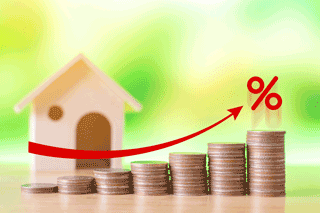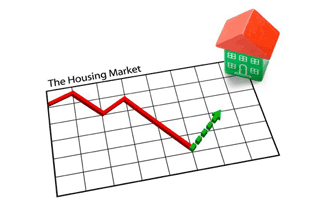Quote Of The Week
“Despite some recent falls, prices are still significantly above their pre-pandemic levels. Regional areas remain up almost 50% since March 2020. Capital city prices are up 25% over the same time period.”
PropTrack Senior Economist Paul Ryan
Pace Of RBA Rate Rises Eases
 In a sign that the current interest rate cycle may be close to ending, the RBA this week increased the cash rate by 25 basis points to 2.6%.
In a sign that the current interest rate cycle may be close to ending, the RBA this week increased the cash rate by 25 basis points to 2.6%.
While borrowers may be concerned about the rise, Mortgage Choice CEO Anthony Waldron says it is a “smaller hit” than previous rises and is a sign the RBA is starting to slow the pace of its “tightening cycle”.
Waldron says recent rate rises have encouraged some home-owners to shop around for better deals on their home loans.
He says while the rises have also resulted in some adjusting to household budgets, that is not being reflected yet in the economic data, which is why the RBA is still trying to combat inflation via rate increases.
“The Reserve Bank’s decision to slow the pace of tightening is great news for households, but I don’t think we’ve seen the end of rate rises yet,” Waldron warns.
Despite the recent rises, Mortgage Choice data shows the vast majority – 96% of borrowers during September – are opting for variable loans.
New Data Shows Correction Is Slowing
 The latest price data provides further indication that the price correction being experienced in some markets has slowed.
The latest price data provides further indication that the price correction being experienced in some markets has slowed.
Both PropTrack and CoreLogic figures show that the pace of decline has slowed in Melbourne, Sydney, Brisbane and generally nationally.
Other capital city and regional markets are still recording price growth.
PropTrack says the pace of price decline slowed in September, falling only 0.19%, which annualised would mean a decrease of about 2.3%.
At the same time Hobart, Regional South Australia and Regional Tasmania recorded monthly increases.
Both PropTrack and CoreLogic figures also show that apartment markets are faring better than house markets overall, and that regional markets continue to outperform city markets.
In the year to date, according to CoreLogic, house prices have fallen 3.9% in the capital cities overall but have risen 3.2% in the combined regional markets.
Nationally apartment markets have dropped only 1.9% in the year to date, but the combined regions have lifted apartment prices 4.6%.
Multiple Moves To Ease Rent Shortage
 The billions of dollars pumped into first home buyer schemes is inflating the cost of entry-level homes and making them less affordable, according to a new report.
The billions of dollars pumped into first home buyer schemes is inflating the cost of entry-level homes and making them less affordable, according to a new report.
The report from the National Housing and Homelessness Agreement says high housing costs are forcing more people into the rental market, exacerbating the rental crisis.
In an effort to free up more accommodation, a number of local councils are trying to force owners to pull their properties out of the short-term leasing market by charging owners higher rates.
Sydney’s Randwick City Council voted to investigate rate variations for holiday rentals and look at the responses of other councils where short-term letting is exacerbating housing shortages and affordability.
In June Brisbane City Council announced an increase in rates of 50% for landlords with holiday renatls who rent out their entire property for more than 60 days a year.
On the Sunshine Coast Noosa Shire Council charges a $950 registration fee for short-term rental accommodation properties.
Renewables To Drive Property Markets
 Property markets in five key regional centres are set to reap the benefits of development of renewable energy infrastructure.
Property markets in five key regional centres are set to reap the benefits of development of renewable energy infrastructure.
InvestorKit head of research Arjun Paliwal says with all three levels of government committed to carbon emissions reduction targets, there will be greater investment in renewable energy which will in turn boost local regional economies and property markets.
He says Rockhampton, Toowoomba, Tamworth-Armidale, Dubbo, and Latrobe Valley area mong the locations to reap the benefits, with the property markets experiencing a boost as people migrate for jobs on the projects.
Demand for rentals will increase, making the regions strong areas for property investment which will ultimately lead to property price growth in those areas.
“Each renewable energy project creates hundreds and even thousands of jobs, particularly in the construction phase,” he says.
“This will see increased demand for housing in regional areas, a revitalisation of regional surrounding towns as new locals bring money to hospitality and retail businesses, and an overall strengthening of its property market.”
Sellers Still Making Big Gains
 The overwhelming majority of sellers are still achieving prices higher than they initially paid, according to the latest CoreLogic Pain and Gain report.
The overwhelming majority of sellers are still achieving prices higher than they initially paid, according to the latest CoreLogic Pain and Gain report.
The report, which analyses 102,000 property resales from the June Quarter, shows 93.8% of sales were for a higher price than the vendor paid originally, down a little on the April Quarter result of 94.1%.
In the June Quarter, the median nominal gain made on re-sales nationally was $270,000, while median losses were $33,500.
CoreLogic head of research Eliza Owen says the smaller capital cities performed well with almost 100% of resales in Canberra and Hobart recording a nominal gain.
Regional markets also performed well, with the rate of loss-making sales dropping to 5.4%.
Ms Owen says there was, however, a small increase in loss-making sales in the combined tree-change and sea-change markets.
“There were slight increases in the rate of loss-making sales across Geelong, the Gold Coast, Richmond Tweed and the Sunshine Coast, but these increases were marginal,” she says.




